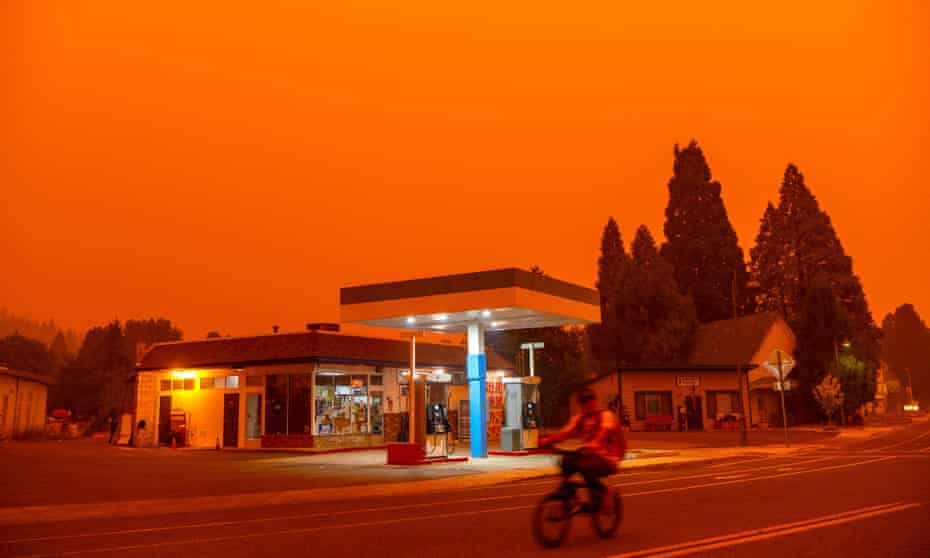Extract from The Guardian
- Fire season on track to break records set last year
- Dixie fire becomes largest in California amid high temperatures
Last modified on Tue 27 Jul 2021 06.59 AEST
At least 85 active wildfires have torched roughly 1.5m acres across 13 US states, mostly in the west, where the parched landscape has fueled the fast-moving flames and caused extreme fire behavior that has proved difficult to contain.
The figures from the National Interagency Fire Center (NIFC) were reported as the 2021 fire season is already on track to break records set last year, when more than 10.6m acres burned. More than 90% of the west is now officially in drought, according to the NIFC, with recent heatwaves setting numerous records in the Pacific north-west, northern Great Basin, and Northern Rockies.
The Dixie fire has become the largest in California after it exploded in size over the weekend and joined with a separate fire. The Dixie fire has scorched close to 197,500 acres and is 22% contained. Officials reported an initial estimate that 16 homes and other structures have been destroyed, but the actual number is assumed to be higher.
Rick Carhart, a Cal Fire public information officer, said damage assessment crews have not yet been able to access the burned areas.
“Part of the problem was they physically weren’t able to see anything because it was so smokey,” he said.
Meanwhile, more than 10,700 homes remain under threat and evacuation orders have been issued in communities in three counties.
The massive fire ignited on 13 July just miles from where the deadly Camp fire erupted in 2018. It is believed to have been caused by faulty Pacific Gas & Electric equipment, which also caused the Camp fire, which killed 86 people and leveled the town of Paradise.
“From the beginning, [the Dixie fire] has been burning away from where the Camp fire burned,” Carhart said. But “that doesn’t necessarily make people in this area feel a lot better. Everyone in this area is still very well aware of the dangers of fire and they don’t like seeing smoke in the air.”
The blaze is burning in areas that are difficult for crews and engines to access, which is complicating containment efforts as more than 2,200 firefighters continue to fight the fire. It has also created large cloud formations that can generate erratic weather conditions, including thunderstorms and dry lightning strikes that can cause new ignitions. Smoke tapered the threat from those clouds over the weekend, Carhart said, but incident meteorologists have forecast that the conditions may be more likely through the beginning of this week.
“If the fire behavior gets too extreme we will pull firefighters off the line and have them back off to wait until the conditions are better, so they can go back to work,” Carhart said.
The Bootleg fire, the largest wildfire in the west, which has burned more than 409,600 acres in Oregon, has also caused erratic conditions through the weekend, forming a tornado along its eastern perimeter, according to officials.
The fire was 53% contained as of Monday morning but it is burning into critically dry timber and shrubs that continue to fuel the flames, with little chance of rain bringing reprieve. Dry lightning is forecast for the area on Monday, but cooler temperatures and higher humidity is also expected to aid in the firefight.
The smoke from fires burning across the west has blanketed the US, causing unhealthy air quality as far away as the east coast.
The smoke from the Dixie fire has also complicated efforts to contain the Tamarack fire, another major fire raging in California, but but crews were able to achieve 45% containment by Monday morning. That fire has burned more than 67,700 acres near the California-Nevada border, as conditions continue to be “hot, dry, and unstable” according to officials. More than a dozen structures have been damaged or lost according to initial estimates, but that number is also expected to grow.
Another extreme heatwave is expected in the coming days, as an enormous “heat dome” is forecast to spike temperatures in the western and central US from California and the Pacific north-west, to the Great Plains and the Great Lakes. Temperatures are expected to range from 15 to 25 degrees higher than average in some areas and could break heat records.
The excessive heat will increase the risk of new ignitions across the region.
“Besides excessive heat, the dome of high pressure aloft will trap smoke from active wildfire areas in the west,” the National Weather Service Prediction Center said in a tweet on Monday. “Numerous air quality alerts dot the region to begin the week.”
Climate change has played a key role in the growing intensity of fires in the west, with hotter and drier conditions increasing ignition risks and causing erratic fire behavior. Fire season is also stretching longer, compounding catastrophes and straining resources.
“Climate affects how long, how hot and how dry fire seasons are,” said Natasha Stavros, an applied science system engineer at NASA’s Jet Propulsion Laboratory in southern California who studies wildfires, on the agency’s blog in February. “As climate warms, we’re seeing a long-term drying and warming of both air and vegetation.”

No comments:
Post a Comment